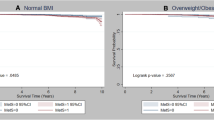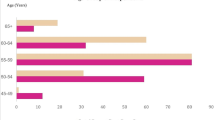Abstract
Purpose
Metabolic factors have been suggested to be associated with breast cancer. However, the findings are inconsistent among studies. We conducted a case–control study in Korean women to evaluate the association between metabolic factors and premenopausal and postmenopausal breast cancer.
Methods
Incident breast cancer cases (270 women) and their controls (540 women) matched by age and menopausal status were recruited from the recipients of a health examination at the same institution. Five relevant factors of metabolic syndrome were evaluated. Odds ratios (OR) and 95 % confidence intervals (CI) for the association were estimated by conditional logistic regression analysis.
Results
Proportions of cases and controls with each factors were 25.6 and 20.6 % for obesity (body mass index ≥ 25 kg/m2), 17.4 and 17.4 % for high fasting glucose (≥5.55 mmol/L or use of hypoglycemic medication), 13.0 and 18.9 % for high triglyceride (≥1.69 mmol/L), 26.3 % and 23.9 % for low high-density lipoprotein cholesterol (<1.29 mmol/L), and 29.6 and 30.6 % for high blood pressure (≥130/or 85 mmHg or use of antihypertensive medication), respectively. Although only the obesity was associated with an increased risk of postmenopausal breast cancer (OR = 2.24; 95 % CI 1.22–4.10) among individual metabolic factors, women with aggregation of three or more metabolic factors as defined by international diabetes federation criteria showed greater risk for postmenopausal breast cancer compared with women without any factor (OR = 2.36; 95 % CI 1.10–5.10).
Conclusions
Although obesity was the only metabolic factor associated with postmenopausal breast cancer, the presence of other metabolic factors may further increase the risk of postmenopausal breast cancer when combined with obesity.
Similar content being viewed by others
Abbreviations
- BMI:
-
Body mass index
- HDL-C:
-
High density lipoprotein cholesterol
References
Jemal A, Murray T, Ward E, Samuels A, Tiwari RC, Ghafoor A, Feuer EJ, Thun MJ (2005) Cancer statistics. CA Cancer J Clin 55(1):10–30. doi:10.3322/canjclin.55.1.10
Toi M, Ohashi Y, Seow A, Moriya T, Tse G, Sasano H, Park BW, Chow LW, Laudico AV, Yip CH, Ueno E, Ishiguro H, Bando H (2010) The Breast Cancer Working Group presentation was divided into three sections: the epidemiology, pathology and treatment of breast cancer. Jpn J Clin Oncol 40(Suppl 1):i13–i18. doi:10.1093/jjco/hyq122
KCCR (2009) Annual report of the central cancer registry in Korea. Central Cancer Registry Center, Korea Central Cancer Registry (KCCR)
Yoo KY, Kim Y, Park SK, Kang D (2006) Lifestyle, genetic susceptibility and future trends of breast cancer in Korea. APJCP 7(4):679–682
Lim S, Shin H, Song J, Kwak SH, Kang SM, Won Yoon J, Choi SH, Cho SI, Park KS, Lee HK, Jang HC, Koh KK (2011) Increasing prevalence of metabolic syndrome in Korea: the Korean National Health and Nutrition Examination Survey for 1998–2007. Diabetes Care 34(6):1323–1328. doi:10.2337/dc10-2109
Calle EE, Kaaks R (2004) Overweight, obesity and cancer: epidemiological evidence and proposed mechanisms. Nat Rev Cancer 4(8):579–591. doi:10.1038/nrc1408
Song YM, Sung J, Ha M (2008) Obesity and risk of cancer in postmenopausal Korean women. J Clin Oncol 26(20):3395–3402. doi:10.1200/JCO.2007.15.7867
Kuriyama S, Tsubono Y, Hozawa A, Shimazu T, Suzuki Y, Koizumi Y, Ohmori K, Nishino Y, Tsuji I (2005) Obesity and risk of cancer in Japan. Int J Cancer 113(1):148–157. doi:10.1002/ijc.20529
Weiderpass E, Braaten T, Magnusson C, Kumle M, Vainio H, Lund E, Adami HO (2004) A prospective study of body size in different periods of life and risk of premenopausal breast cancer. Cancer Epidemiol Biomarkers Prev 13(7):1121–1127
Tian YF, Chu CH, Wu MH, Chang CL, Yang T, Chou YC, Hsu GC, Yu CP, Yu JC, Sun CA (2007) Anthropometric measures, plasma adiponectin, and breast cancer risk. Endocr Relat Cancer 14(3):669–677. doi:10.1677/ERC-06-0089
Friedenreich CM (2001) Review of anthropometric factors and breast cancer risk. Eur J Cancer Prev 10(1):15–32
Alberti KG, Zimmet P, Shaw J (2006) Metabolic syndrome—a new world-wide definition. A consensus statement from the international diabetes federation. Diabetic Med J Br Diabetic Assoc 23(5):469–480. doi:10.1111/j.1464-5491.2006.01858.x
Grundy SM, Cleeman JI, Daniels SR, Donato KA, Eckel RH, Franklin BA, Gordon DJ, Krauss RM, Savage PJ, Smith SC Jr, Spertus JA, Costa F (2005) Diagnosis and management of the metabolic syndrome: an American Heart Association/National Heart, Lung, and Blood Institute Scientific Statement. Circulation 112(17):2735–2752. doi:10.1161/CIRCULATIONAHA.105.169404
Furberg AS, Veierod MB, Wilsgaard T, Bernstein L, Thune I (2004) Serum high-density lipoprotein cholesterol, metabolic profile, and breast cancer risk. J Natl Cancer Inst 96(15):1152–1160. doi:10.1093/jnci/djh216
Soler M, Chatenoud L, Negri E, Parazzini F, Franceschi S, la Vecchia C (1999) Hypertension and hormone-related neoplasms in women. Hypertension 34(2):320–325
Xue F, Michels KB (2007) Diabetes, metabolic syndrome, and breast cancer: a review of the current evidence. Am J Clin Nutr 86(3):s823–s835
Kabat GC, Kim M, Chlebowski RT, Khandekar J, Ko MG, McTiernan A, Neuhouser ML, Parker DR, Shikany JM, Stefanick ML, Thomson CA, Rohan TE (2009) A longitudinal study of the metabolic syndrome and risk of postmenopausal breast cancer. Cancer Epidemiol Biomarkers Prev 18(7):2046–2053. doi:10.1158/1055-9965.EPI-09-0235
Agnoli C, Berrino F, Abagnato CA, Muti P, Panico S, Crosignani P, Krogh V (2010) Metabolic syndrome and postmenopausal breast cancer in the ORDET cohort: a nested case–control study. Nutr Metab Cardiovasc Dis 20(1):41–48. doi:10.1016/j.numecd.2009.02.006
Russo A, Autelitano M, Bisanti L (2008) Metabolic syndrome and cancer risk. Eur J Cancer 44(2):293–297. doi:10.1016/j.ejca.2007.11.005
Chen TH, Chiu YH, Luh DL, Yen MF, Wu HM, Chen LS, Tung TH, Huang CC, Chan CC, Shiu MN, Yeh YP, Liou HH, Liao CS, Lai HC, Chiang CP, Peng HL, Tseng CD, Yen MS, Hsu WC, Chen CH (2004) Community-based multiple screening model: design, implementation, and analysis of 42,387 participants. Cancer 100(8):1734–1743. doi:10.1002/cncr.20171
Inoue M, Noda M, Kurahashi N, Iwasaki M, Sasazuki S, Iso H, Tsugane S (2009) Impact of metabolic factors on subsequent cancer risk: results from a large-scale population-based cohort study in Japan. Eur J Cancer Prev 18(3):240–247. doi:10.1097/CEJ.0b013e3283240460
Bjorge T, Lukanova A, Jonsson H, Tretli S, Ulmer H, Manjer J, Stocks T, Selmer R, Nagel G, Almquist M, Concin H, Hallmans G, Haggstrom C, Stattin P, Engeland A (2010) Metabolic syndrome and breast cancer in the me-can (metabolic syndrome and cancer) project. Cancer Epidemiol Biomarkers Prev 19(7):1737–1745. doi:10.1158/1055-9965.EPI-10-0230
Osaki Y, Taniguchi S, Tahara A, Okamoto M, Kishimoto T (2012) Metabolic syndrome and incidence of liver and breast cancers in Japan. Cancer Epidemiol 36(2):141–147. doi:10.1016/j.canep.2011.03.007
Low S, Chin MC, Ma S, Heng D, Deurenberg-Yap M (2009) Rationale for redefining obesity in Asians. Ann Acad Med Singapore 38(1):66–69
Kim Y, Park SK, Han W, Kim DH, Hong YC, Ha EH, Ahn SH, Noh DY, Kang D, Yoo KY (2009) Serum high-density lipoprotein cholesterol and breast cancer risk by menopausal status, body mass index, and hormonal receptor in Korea. Cancer Epidemiol Biomarkers Prev 18(2):508–515. doi:10.1158/1055-9965.EPI-08-0133
Ha M, Sung J, Song YM (2009) Serum total cholesterol and the risk of breast cancer in postmenopausal Korean women. CCC 20(7):1055–1060. doi:10.1007/s10552-009-9301-7
Muti P, Quattrin T, Grant BJ, Krogh V, Micheli A, Schunemann HJ, Ram M, Freudenheim JL, Sieri S, Trevisan M, Berrino F (2002) Fasting glucose is a risk factor for breast cancer: a prospective study. Cancer Epidemiol Biomarkers Prev 11(11):1361–1368
Rapp K, Schroeder J, Klenk J, Ulmer H, Concin H, Diem G, Oberaigner W, Weiland SK (2006) Fasting blood glucose and cancer risk in a cohort of more than 140,000 adults in Austria. Diabetologia 49(5):945–952. doi:10.1007/s00125-006-0207-6
Jee SH, Ohrr H, Sull JW, Yun JE, Ji M, Samet JM (2005) Fasting serum glucose level and cancer risk in Korean men and women. JAMA 293(2):194–202. doi:10.1001/jama.293.2.194
Mink PJ, Shahar E, Rosamond WD, Alberg AJ, Folsom AR (2002) Serum insulin and glucose levels and breast cancer incidence: the atherosclerosis risk in communities study. Am J Epidemiol 156(4):349–352
Oda E, Kawai R (2010) Comparison among body mass index (BMI), waist circumference (WC), and percent body fat (%BF) as anthropometric markers for the clustering of metabolic risk factors in Japanese. Intern Med 49(15):1477–1482
Abbasi F, Malhotra D, Mathur A, Reaven GM, Molina CR (2012) Body mass index and waist circumference associate to a comparable degree with insulin resistance and related metabolic abnormalities in South Asian women and men. Diabetes Vasc Dis Res Off J Int Soc Diabetes Vasc Dis 9(4):296–300. doi:10.1177/1479164111433578
Korean Ministry of Health and Welfare (2008) National Health and Nutrition Examination Survey Report 2007. Ministry of Health and Welfare, Seoul
Acknowledgments
This research was supported by the Basic Science Research Program through the National Research Foundation of Korea (NRF) funded by the Ministry of Education, Science and Technology (20120004255).
Conflict of interest
The authors have no conflicts of interest to disclose.
Author information
Authors and Affiliations
Corresponding author
Electronic supplementary material
Below is the link to the electronic supplementary material.
Rights and permissions
About this article
Cite this article
Noh, HM., Song, YM., Park, JH. et al. Metabolic factors and breast cancer risk in Korean women. Cancer Causes Control 24, 1061–1068 (2013). https://doi.org/10.1007/s10552-013-0183-3
Received:
Accepted:
Published:
Issue Date:
DOI: https://doi.org/10.1007/s10552-013-0183-3




